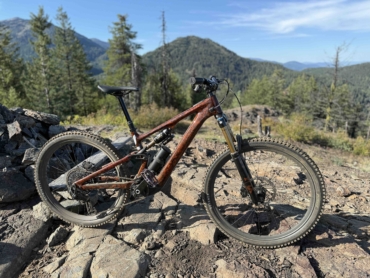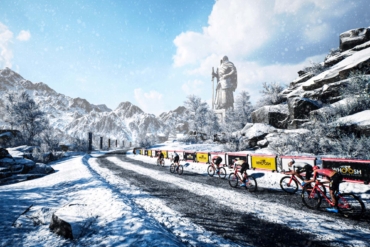By T.C. WORLEY
Log piles, “extreme difficulty”-rated rock gardens, flights of stairs, and tacky mud holes have all taken a heavy mocking from my new bike. Equipped with obese, 26 × 4-inch tires rigged on Salsa’s Ti Mukluk frameset, this beast of a bike was dreamt up for riding through snow and over terrain that would normally stop a mountain bike in its tracks. The tires come from 45Nrth, a new brand under QBP, and the model is the Husker DÜ, which roll, grip, and crush almost anything in their way. For the white stuff, the 4-inch-wide rubber is to bikes what snowshoes are for human feet.
For the last few weeks, I’ve been riding this “snow-bike” on trails and pavement in my oddly snow-less home city of Minneapolis. We had no white Christmas this year, and January is mild and slushy still. But even on dry land and mud, the chubby-tire’d Mukluk can be a fun and performance-enhancing ride.
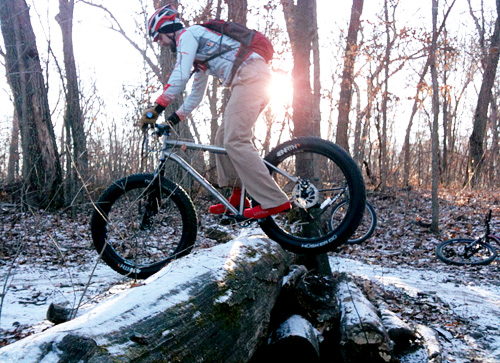
Many riders I talk to assume this genre of extra-fat-tire “niche” bike is too costly to justify or own. For sure the titanium version of the Mukluk, which I tested, is costly at $2,100 as a bare frameset. But the Mukluk 3, a full build, can be had for around $1,600, making a snow-bike an easier sell for riders wanting something in this area to add to their “quiver.”
To be sure, there are some big limitations with the Mukluk. It is a heavy beast. My titanium test bike, the very lightest in the line, still weighed in at 31 pounds. On pavement, you feel the sluggishness. On a recent ride in the city, I literally trudged the bike uphill into a stiff headwind. Compared to my speedy town commuter, the rolling resistance was very substantial and the steering slow and dull; it felt frustratingly slow.
But on the city ride the fat tires were also smoothing out every bump I’d normally have to steer around. On the way home that day, with that same big wind then at my back, I longed for more gears as I coaxed the pig into a 17-mph trot, smiling the entire ride back.
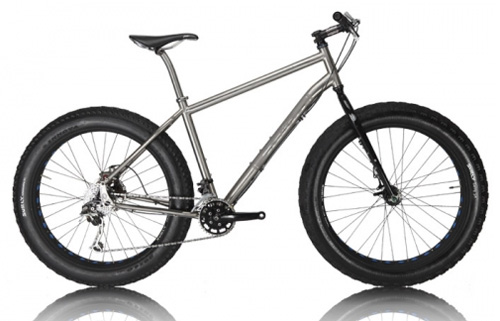
Compared to a normal mountain bike, the Mukluk rolls slower for sure. But it begs to be ridden off of curbs and through the nastiest potholes in town, a tank of a commuter that slows for little at all.
Off the road and onto trails, the sluggish and oafish behavior dissipates as the Mukluk barrels down the dirt with purpose and force. Logs, roots, and big ruts are no match for the inertia and mass of this bike. Its overall weight is great for momentum, but it is still there and very noticeable on the hills. Pedal-powered monster truck? Yep, that’s the analogy here no doubt.
There is a penalty for all the mass, however. Turning is a weakness whenever there is traction — the tires’ large footprint sets up an arm-wrestling match of sorts with the handlebars in tight corners. Learn to use your body, leaning the whole bike and you’ll do fine. (And the hidden benefit: The bike wants to track straight, which means log rides and the like are a cinch!)
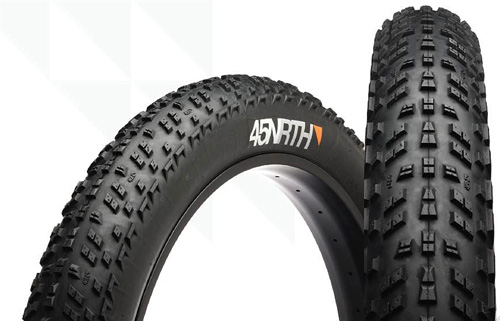
Handling is not quite as nimble and mountain-bike-like as the original snowbike, the Surly Pugsley. Salsa designed its Mukluk with a more-relaxed geometry and lower center of gravity (via a lower bottom bracket) reckoned to be more ideal for snow travel. Some riders have likened the handling difference between the two models as such: The Pugsley handles like a mountain bike, and the Mukluk is more like a touring bike for loose conditions.
As noted, my test bike weighed approximately 31lbs. Not bad considering the size, but certainly that is a lot of weight when the terrain slopes upward. You’ll notice the weight, no doubt, but settle in and “granny down” to climb anything you can find because this thing has traction all day long.
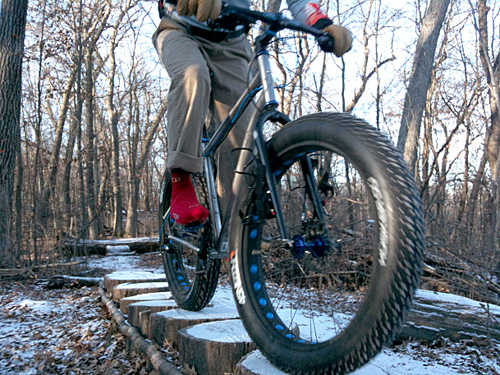
The tires, 45Nrth’s Husker DÜ model, cost $120 each. They are new to the market this year and aim to fill a gap by “delivering a fatbike tire with low rolling resistance and high amounts of acceleration, braking and cornering traction,” as the brand puts it. I found them to have plenty of each — in corners with a light dusting of snow, I sprung out of the saddle in a full sprint to try and break traction. I failed. Leaned over, pedaling with my all, the tires held. Save for glare ice, the Husker DÜ’s owned every surface I rode.
Another advantage to the fatties: You can roll at incredibly low air pressure, like 7-10 psi and lower (way lower in snow), which adds substantially to the “grip” equation with even more rubber on the ground. Moreover, shocks are superfluous with these balloons — the fat tires suck in the bumps and give a substantial buffer, though there is more “bounce back” as opposed to absorption like what you get in a dual-suspension rig. The lack of shocks saves a chunk of weight and a lot on the cost of these bikes, which are almost universally ridden with rigid forks and hardtail frames.
It’s been a weird winter in Minnesota this year. So far, I have barely ridden on more than a dusting of snow, but I am having a blast still on this snow-bike. I suggest we begin thinking of these bikes as “all-terrain” and not merely for snow. Stay tuned as we will (hopefully) get some of the white stuff this month. I’m ready to ride the powder and hit the local trails once again for round No. 2 of our Mukluk/45Nrth bike test.
—T.C. Worley is a contributing editor.
